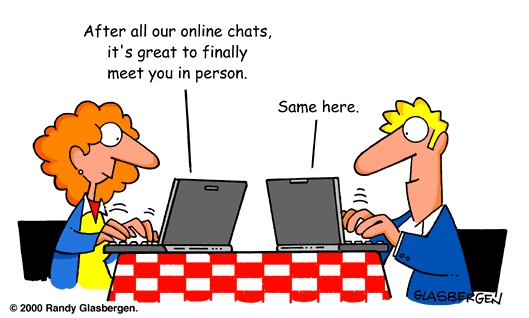Jacob Morgan's Blog, page 34
March 31, 2014
Collaboration and the Online Dating Syndrome
Anyone that has tried online dating can tell you that the person you see online isn’t always the same person that you see in real life. See, the problem with online dating is that people can make themselves look like anyone they want online. This is the same problem with many organizations today.
Organizations today are overly enamored with collaboration solutions, sharing, and the future of work. They say they want employees to share, to communicate across silos, to innovate, to collaborate and be open, and to be empowered (and oh so much more!) To do this, many companies deploy a collaboration technology, throw some training around it, and maybe get an executive to speak at a Town Hall meeting or prepare a video about why this new direction is so important. This is the equivalent to telling people you’re 6’1″ and a lean 170 lbs, have a successful career as a corporate executive, and drive a Porsche, when in reality you’re 5’6,” 195 lbs, unemployed, and drive a Honda.
If your company: rewards only individual performance, uses stack ranking, has annual employee reviews, forces employees to wear a suit and tie to work, has people in cubicles, forces employees to get permission for every expense, employs a strict hierarchy, treats executives like mythical unicorns that should looked up with awe and worship, and then deploys collaboration platforms in an attempt to get everyone to share; well then you are working at an organization that is clearly experiencing the online syndrome and need to be brought back to reality. You can’t tell employees to act one way online while encouraging a completely different type of behavior in real life.
The key here is that the online version of your company needs to emulate the physical version of your company. In the scenario mentioned above do you think anyone would be willing to share or collaborate? Absolutely not! Digital transformation starts with the physical world. Start making changes that go beyond technology to see results. Here are just a few of many things you can explore:
Get rid of cubicles and go with open space
Instead of a strict hierarchy encourage employees to communicate with other departments or employees with varying seniority levels
Go for real-time feedback instead of annual reviews
Forget getting every single expenses approve by managers, employees should be able to buy pens or a desk!
Create innovation jam sessions
Integrate collaboration into the vision or mission of the company
Get rid of your managerial titles
Encourage vulnerability in the workforce
Experiment with flexible work environments
I’m sure you can think of a hundred other things that can be done at your organization, but why isn’t anyone doing them? You have to create the type of environment and corporate culture that will support and encourage the behaviors that you want to see in the workplace; otherwise nobody will want date you.
 Send to Kindle
Send to Kindle




March 27, 2014
Before Doing Anything Else
Putting together a strategy, looking at collaboration technologies, and building a team to lead future of work and collaboration initiatives is crucial. But before getting to any of that there is something else that needs to done. And that is for you and your executives to decide to build and work at the type of organization that will require a collaboration strategy, technologies, and a team to lead this effort. In other words before focusing on anything else, ask yourself if this is something you are willing to commit to. The first step to building the future organization is deciding that you want to build the future organization.
 Send to Kindle
Send to Kindle




March 25, 2014
Webinar With OpenText Tomorrow on Collaboration
Tomorrow (Wed. March 26th at 8am PST) I’ll be hosting a webinar with Opentext all around my favorite topic, the future of work and collaboration! The “meat” of the webinar will talk about the 5 common mistakes that organizations make when deploying their collaboration technologies/strategies and how to avoid them. I’ll also be sharing a few sneak peaks of my new book, The Future of Work. I hope you can make it. Register here!
 Send to Kindle
Send to Kindle




March 18, 2014
Explaining the Importance of Weak Ties
Last week I put up an article on Forbes on Why Every Employee Should Be Building Weak Ties At Work which I highly recommend you check out. Along with that article I also created a video in which I explain the difference between strong and weak ties and why weak ties are so crucial in the workplace. If you’re interested in these types of topics around the future of work and collaboration then make sure to subscribe to the Youtube Channel!
 Send to Kindle
Send to Kindle




March 12, 2014
Are You Subscribed to the Collaboration and Future of Work Newsletter?
 If you haven’t subscribed to our newsletter yet, not only am I sad and disappointed, but you are missing out! We just redesigned it and expanded the content a bit to shift from just focusing on collaboration to targeting the future of work and collaboration. That means that you will content ranging from how to create a flexible work environment to the trends shaping the future of work to how to successfully deploy collaboration technologies at your organization. Every week we hand select the top 3-5 articles that we feel are worth your time. The articles will be a mix of strategic content and thought provoking ideas. Some of the content might come from large media outlets such as the New York Times while other content might come from bloggers that you have never heard of.
If you haven’t subscribed to our newsletter yet, not only am I sad and disappointed, but you are missing out! We just redesigned it and expanded the content a bit to shift from just focusing on collaboration to targeting the future of work and collaboration. That means that you will content ranging from how to create a flexible work environment to the trends shaping the future of work to how to successfully deploy collaboration technologies at your organization. Every week we hand select the top 3-5 articles that we feel are worth your time. The articles will be a mix of strategic content and thought provoking ideas. Some of the content might come from large media outlets such as the New York Times while other content might come from bloggers that you have never heard of.
We have thousands of subscribers from all over the world who rely on us to act as their filter for the important information related to the future of work and collaboration. It’s easy to get lost in a world of endless content which is why we created this newsletter. We even have a few subscribers whose managers make this newsletter mandated weekly reading so that they can stay up to date with what is happening in the world of work. I speak at conferences all over the world and one of the things that always fascinates me is that I get people that come up to me after my session and say, “I get your newsletter.”
We are always looking to improve and are open to your suggestions, recommended articles, or content ideas, so don’t be a stranger.
In the meantime make sure to subscribe to our new and improved newsletter on the future of work and collaboration, you will be glad you did!
In case the inserted hyperlinks above were obvious: click here to subscribe!
 Send to Kindle
Send to Kindle




March 10, 2014
Millennials in the Workplace, Are They Really That Scary?
 You’ve heard of millennials right? Those weird looking new people that are starting to enter our organizations? Countless articles have already been written about them but the tone seems to be one of “freaking out.” Millennials are being painted as these type of far-off aliens who are going to be inhabiting our world and changing everything. So, let me assure you that there is no need to panic. Yes, it’s true, millennials will be the majority of the workforce in the next few years and yes, this does mean introducing new attitudes and ways of working and thinking about work. But there are three reasons why you shouldn’t freak out about millennials in the workplace.
You’ve heard of millennials right? Those weird looking new people that are starting to enter our organizations? Countless articles have already been written about them but the tone seems to be one of “freaking out.” Millennials are being painted as these type of far-off aliens who are going to be inhabiting our world and changing everything. So, let me assure you that there is no need to panic. Yes, it’s true, millennials will be the majority of the workforce in the next few years and yes, this does mean introducing new attitudes and ways of working and thinking about work. But there are three reasons why you shouldn’t freak out about millennials in the workplace.
Millennials are one of several trends impacting the future of work
There are several trends which are impacting the future of work and millennials entering the workforce are certainly one of those trends. However, we still need to pay attention to the other things which are happening in the world of work as well. Things like globalization, new technologies, and new behaviors which are dramatically shaping how work will get done. I’m not saying millennials aren’t an important factor here, they are, but at the same time they aren’t the only piece of the puzzle. Instead of focusing on and isolating the millennial factor we need to look at it in the context of the other shifts which are taking place in the world of work. If millennials are the only thing you’re concerned with then you have much bigger problems to worry about.
It’s not the first time “different” people have worked together
Any time you bring together groups of people you will have different values, ideas, preferences, and ways of working; that’s just what it means to be human and work for an organization. The picture being painted today is that since we have five generations working together that it’s time to panic. The values, ideas, ways of working and thinking about work which are being discussed aren’t that new, it’s just that there’s more people thinking in new and progressive ways. If you removed all millennials from your organization I can guarantee that there will still be plenty of employees who prefer flexible work, coaching and mentoring, more rapid response and feedback, and those who care about their community and corporate sustainability efforts.
The shift is gradual
As of now millennials are not the majority of the workforce but they will be in the next six years. It’s not as though one day we will wake up and there will be millennials running around our organizations like gremlins. Most people are well aware that this shift is happening and in fact many organizations are already preparing for it and trying to figure out what they need to do adapt. However, for some reason there has been this assumption that the future employee implies millennial, but that’s not true. The future employee is anyone who with new attitudes about work, new ways of thinking about working, and new ways of working. This person can be 18 or 68.
Millennials are acting as powerful catalyst because of the amount of them that are entering the workforce, but the new values, attitudes, and ways of working are already inside your organization and growing.
I talk about these these in more detail in the video below but the point is there’s no sense freaking out, take a deep breath, everything will be fine. Make sure to subscribe to the channel for more videos on the future of work.
 Send to Kindle
Send to Kindle




February 27, 2014
Book Update-Manuscript is Done!
Towards the end of October of last year I announced that I was working on a new book for Wiley around the future of work. Tomorrow, I hand in my manuscript which is just over 60,000 words. I researched and interviewed many companies for this book and am excited to see this manuscript in it’s finished form. I had several illustrations and graphics created specifically for this new book which will also be seen in upcoming presentations and articles. For now I get to take a short breather while the folks at Wiley start the editing process. In the meantime I’m working on my next book for Forbes around collaboration and will be coming up with some marketing ideas for my Wiley book.
I will post a link to the book once it is available on Amazon. Tomorrow Wiley will send me a hi-res image of the book cover which I can share with everyone. I’m happy with the end result. We are still on track for a Sept 2nd launch date and I’m going to try to plan some exciting events and book launches around that, but more on that later. In the meantime, the book is done and off to the publisher for editing; now the fun begins!
Thanks for all of your support.
 Send to Kindle
Send to Kindle




February 12, 2014
In Amsterdam Keynoting The Social Conference
Hello from the Netherlands!
After a 4 hour flight from San Francisco to Chicago and then another 8 hour flight from Chicago, I (and my fiance Blake), finally made it to Amsterdam where I will be keynoting The Social Conference. We are staying in a hotel that once used to be a prison during World War II; kind of creepy but also a pretty cool and unique experience. It certainly has a lot of character with steep marble staircases, long corridors, and unique room layouts. We have a nice view of the river from all the rooms in the hotel which is nice.

Next to the central station in Amsterdam

Our hotel lobby/cafe area, very European!

Walking around in “old town” Amsterdam, you can see Blake in the background
The weather here is freeeezing, ok maybe not freezing, but 40 degrees is pretty darn cold for us Californians! Blake and I had to turn back a bit early from our all day adventure because we thought we were going to freeze on the streets. Thankfully hot coffee is a good anti-freeze!
My session is tomorrow morning (the 13th) and my topic is going to be all around building a collaborative organization, something I’m quite passionate about and have been spending quite a lot of time working on and researching. I’m looking forward to sharing my ideas and also learning a lot from the Dutch crowd of around 350-400 people.
I think it’s the first time Blake and I have spoken at a conference together but we get to spend Valentine’s Day in Amsterdam which is a unique experience. I’m lucky to be able to travel to great places around the world and share my thoughts and ideas around the future of work and collaboration. I’m even more lucky that I get to do it with Blake!
Hope you are all having a great week!
 Send to Kindle
Send to Kindle




February 4, 2014
Change is the Only Constant and it Will Kill Hierarchy

The one thing we can always be certain of is that things keep changing and we don’t always know what those changes are going to bring. The big difference for organizations today is that change is happening faster, in other words more changes are occurring and the rate at which those changes are occurring are increasing. Hierarchies cannot possibly succeed in this type of an environment because they are too rigid. When most large companies try to move too quickly they break apart and crumble.
In a rapidly changing environment the only way to succeed is to give more people (not less!) access to information, authority, and decision making power to spot opportunities, come up with ideas, and generate solutions for problems that might be on the horizon. Organizations must get comfortable with experimentation and with trying things out to see what works and what doesn’t. Traditional corporate structures simply don’t allow for this type of maneuverability. Every organization I speak with or work with is telling me how they want to become “flatter” for this exact reason.
Hierarchies are great in static environments because they act as giant indestructible monoliths. But we live and work in a dynamic environment, are you willing to bet the future of your company on that type of a pyramid structure? I didn’t think so.
 Send to Kindle
Send to Kindle




January 30, 2014
5 Ways Email Makes Your Employees Hate Their Jobs

It can sound like a gentle wave, an eager ding, or perhaps a vibration on our phone felt from a pocket. It’s email, and regardless of how much we talk about the future of work and collaboration, we cannot ignore this blaring reality of all employee lives. Email keeps us handcuffed to our phones and computers–always alert to that distracting delivery notification of a new message.
It’s like a virus spreading beyond containable proportions. It has become an out of control situation.
We use email for everything related to communication and collaboration at work even though it’s no longer the most effective way to do either. Everyone has an email account. Its widespread reach is both its greatest strength and biggest weakness. There are five ways that email is making the lives of employees around the world today miserable.
Too much of it
There are around 90 billion business emails sent out every single day. According to Mimecast, an enterprise email management company, we spend around half of our working day (four hours) using email (although other reports have this number to be at around 25-30%). Additionally, 39% of users regularly send, receive, and check emails outside of working hours (Mimecast “The Shape of Email 2012″). This means that half of what we get paid to do as employees is use email. This a scary statistic.
The amount of email employees get is so overwhelming that it’s oftentimes one of the first things people check in the morning and one of the last things they do before retiring to bed. Radicati Group estimates that employees receive around 78 business emails a day and send around 37 a day. This brings the total to around 115 emails a day (sent and received)! On average employees check their email 36 times an hour which amounts to 288 times a day for an eight hour work day. To make matters worse it takes employees around 16 minutes to refocus on their tasks after handling email. The fact that employees get so much email every day (and this is just business email), means employees have to work longer hours. This is because half of their time at work isn’t actually spent working. Bottom line, too much email makes employees miserable.
Forwarded conversations
Forwarding long threaded email conversations has become the norm for looping other team members in. Since email is the default communication medium in most companies, when an employee needs to join the conversation he or she is conveniently sent a massive forwarded email thread which kindly says “see below.” This employee is now stuck weeding through a massive, unformatted, and disorganized email thread. Quite simply this takes accountability off the sender by sending a message similar to: “I forwarded you the conversation so you should have all the info you need.” This tactic is not only ineffective but it’s time consuming. It also makes the lives of employees…miserable.
Rapid response expectation
When email first came out it was used for asynchronous communication. You would send an email and in a day or two would get a response back. Nowadays if you don’t respond to someone’s email in a few hours they think you’re dead. Most employees are essentially email slaves. Now that employees can check and respond to email on their mobile devices they are forever connected to the email overlords. Not only have companies created a work culture where employees are expected to respond to emails right away, but many of them are expected to do so on the weekends too. In a study by Good Technology they found that 38% of employees routinely check work email at the dinner table, 50% do so while still in bed, and 69% won’t even go to bed without first checking their email.
This expectation that employees always need to be checking and responding to emails makes employees…miserable.
Used for everything and anything
Want to share a document with someone? Email it. Want to invite an employee to an event? Email them. Need to ask a question? Email it. Need to send a one word response to something? Email it. Want to send meeting notes to your team? Sure, just type them up in your email and blast it out to everyone.
Email has gotten out of control to the point where it’s used for everything and anything. Today only around one in three emails is essential for work. To give you an analogy, imagine trying to fix every problem in your house with just a screwdriver. Regardless of what the problem is, you have that trusty screwdriver to help you out even though it’s clearly not the best suited tool for most of what you need to get done. The fact that companies use email for everything and anything makes employees miserable
Email as the company therapist
You ever get those emails from someone only to find that what you’re reading sounds like it should be contained in a personal diary of the person who sent it? Oftentimes employees can send out verbose emails with scattered ideas that colleagues are expected to read just to find that one piece of relevant information that they need. It’s kind of like a weird game where I send you an essay and say “find the one sentence in this text that answers your question.” No matter what this schizophrenic email says employees are expected to read it. Finally, the fact that employees are expected to read everything that comes their way makes employees…miserable.
The hard truth is that email is not the most effective tool for communication or collaboration. There are better technologies and strategies out there. Stay tuned for my second post providing actionable advice on how to stop making employees miserable with email.
In the meantime, let’s stop making the lives of employees miserable!
 Send to Kindle
Send to Kindle








